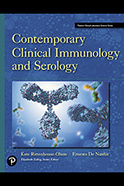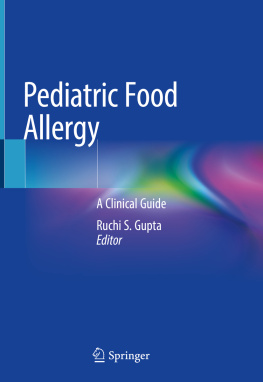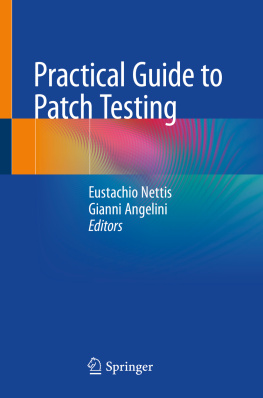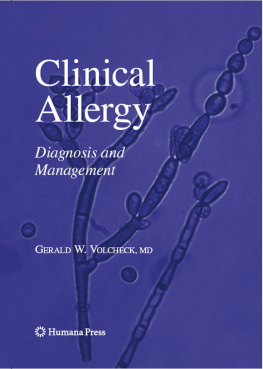Cover

Provocation Testing in Clinical Practice
CLINICAL ALLERGY AND IMMUNOLOGY
Series Editor
M ICHAEL A. K ALINER , M.D.
Medical Director
Institute for Asthma and Allergy
Washington, D. C.
- Sinusitis: Pathophysiology and Treatment, edited by Howard M. Druce
- Eosinophils in Allergy and Inflammation, edited by Gerald J. Gleich and A. Barry Kay
- Molecular and Cellular Biology of the Allergic Response, edited by Arnold I. Levinson and Yvonne Paterson
- Neuropeptides in Respiratory Medicine, edited by Michael A. Kaliner, Peter J. Barnes, Gert H. H. Kunkel, and James N. Baraniuk
- Provocation Testing in Clinical Practice, edited by Sheldon L. Spector
ADDITIONAL VOLUMES IN PREPARATION
Mast Cell Proteases in Immunological Responses, edited by George H. Caughey
| title | : | Provocation Testing in Clinical Practice Clinical Allergy and Immunology ; 5 |
| author | : | Spector, Sheldon L. |
| publisher | : | Informa Healthcare |
| isbn10 | asin | : | 0824792491 |
| print isbn13 | : | 9780824792497 |
| ebook isbn13 | : | 9780585377964 |
| language | : | English |
| subject | Provocation tests (Medicine) , Bronchial provocation tests, Allergy--Diagnosis, Hypersensitivity, Bronchial Provocation Tests, Nasal Provocation Tests, Immunologic Tests. |
| publication date | : | 1995 |
| lcc | : | RC587.P76P74 1995eb |
| ddc | : | 616.97/075 |
| subject | : | Provocation tests (Medicine) , Bronchial provocation tests, Allergy--Diagnosis, Hypersensitivity, Bronchial Provocation Tests, Nasal Provocation Tests, Immunologic Tests. |
Page i
Provocation Testing in Clinical Practice
edited by
Sheldon L. Spector
Allergy Medical Clinic and Allergy Research Foundation
Los Angeles, California

Page ii
Library of Congress Cataloging-in-Publication Data
Provocation testing in clinical practice / edited by Sheldon L. Spector.
p. cm. (Clinical allergy and immunology; 5)
Includes bibliographical references and index.
ISBN 0-8247-9249-1 (alk. paper)
1. Provocation tests (Medicine) 2. Bronchial provocation tests.
3. AllergyDiagnosis. I. Spector, Sheldon L. II. Series.
[DNLM: 1. Hypersensitivity. 2. Bronchial Provocation Tests. 3. Nasal
Provocation Tests. 4. Immunologic Tests. W1 CL652 v. 5 1995 / QW 900 P968
1995]
RC587.P76P74 1995
616.97075dc20
DNLM/DLC
for Library of Congress 94-33912
CIP
The publisher offers discounts on this book when ordered in bulk quantities. For more information, write to Special Sales/Professional Marketing at the address below.
This book is printed on acid-free paper.
Copyright 1995 by Marcel Dekker, Inc. All Rights Reserved.
Neither this book nor any part may be reproduced or transmitted in any form or by any means, electronic or mechanical, including photocopying, microfilming, and recording, or by any information storage and retrieval system, without permission in writing from the publisher.
Marcel Dekker, Inc.
270 Madison Avenue, New York, New York 10016
Current printing (last digit):
10 9 8 7 6 5 4 3 2 1
PRINTED IN THE UNITED STATES OF AMERICA
Page iii
Preface
There are a multitude of books dealing with general topics such as asthma, eye conditions, rhinitis, or skin diseases; however, there are very few, if any, dealing with provocative challenges to various organs in the body. My interest in provocative challenges has led me to seek out experts who could provide background information as well as details regarding the challenges themselves. This book will therefore serve as a rather unique reference work.
Many articles have appeared on scientific programs regarding pharmacological challenges such as methacholine and histamine, and the number of such challenges continues to increase. Adenosine and leukotriene challenges were virtually unheard of only a few years ago. Some of the challenges discussed in this volume are induced from natural sources such as air pollution and infectious agents. In vitro studies and animal models that have helped us understand mechanisms are also included in this book.
The main thrust of this work, however, represents details regarding challenges in humans. This means that guidelines must be utilized for the proper performance of such challenges to be done in a scientific and moral way. Humans are not as homogeneous as many of the animals that are studied, so it is not unusual for a paradoxical or unpredictable response to occur. This is an even greater reason for precautions to be taken, since quantification becomes important. The dose of metabisulfite or aspirin administered to someone with asthma must be tailored to the potential disease as well as the heterogeneous patient. As new data emerge, so dose the breadth of the discussion on challenges. Even a few years ago it was not
Page iv
appreciated that certain loop diuretics might protect against provocative challenge. Medications such as adenosine or one of the products of the arachidonic acid pathway were also not mentioned because they had not been isolated or purified to the point of giving a challenge. Many procedures described in this volume are of practical value to the practicing physician since skin tests in both immediate, delayed, and contact sensitivity are discussed.
This book will prove important to clinical researchers, interested in the various aspects of allergy, clinical immunology, and pulmonary medicine. There is an in-depth discussion of the background as well as the practical aspects of performing these challenges for those who are interested in state-of-the-art procedures. In this respect, the volume will be a reference guide for serious investigators as well as a guide to the practicing allergist/immunologist. In addition, there is an international character to this compendium, with authors from such places as England, Australia, France, and Canada. I sincerely wish that the information provided in this book will serve the physician well in understanding the mechanisms, diagnosis, and even treatment when normal physiological mechanisms are challenged.
Sheldon L. Spector
Page v
Contents
| Preface | iii |
| Contributors | ix |
| 1 | Allergenic Extracts
John W. Yunginger | 1 |
| 2 | Standardization of Allergens
Jean Bousquet and Franois-B. Michel | 15 |
| 3 | Use of the Skin Blister Model and Intradermal Testing to Explore the Pathogenesis and Pharmacological Control of Cutaneous Allergic Inflammation
William A. Massey and Lawrence M. Lichtenstein | 51 |
Next page









